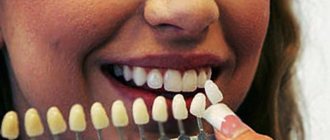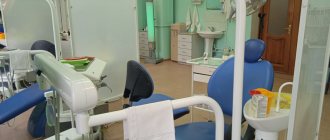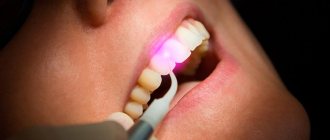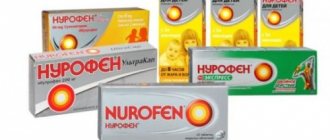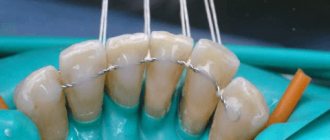Everyone wants to be the owner of a beautiful snow-white smile. This is why professional teeth whitening has become so popular recently. But in order for the result to be maximum and last a long time, you need to follow some rules for oral care. If you do not follow the specialist’s recommendations, fairly soon after the procedure your teeth will return to their previous shade.
Restrictions after the procedure and terms of their observance
As a rule, after the procedure, the specialist gives the patient a leaflet indicating foods and drinks that should be avoided - the so-called white diet. In addition, the leaflet provides general recommendations that must be followed.
The transparent or white diet is a special diet that you need to follow after teeth whitening. Following such a diet will help avoid staining or darkening of lightened enamel.
First of all, the diet implies the exclusion of coloring pigment from the list of foods and drinks consumed. Already from the name of the diet it is clear that it includes light-colored foods.
Ongoing care after whitening
High-quality hygiene. General rules are standard. Brush your teeth twice a day using toothpaste selected by your dentist. Floss is regularly used to clean the cervical part of the crown, lateral surfaces, and interdental space. It is advisable to use an irrigator twice a week to remove soft plaque.
Visits to the dentist. Performed once every 4-6 months for preventive examination and professional cleaning. During visits, the doctor monitors the result of whitening, changes in the color of tooth enamel, and carries out procedures to strengthen it.
Supportive procedures. To consolidate the whitening result and prolong it, do the following:
- professional teeth cleaning. A quick and painless procedure for removing soft plaque, developing tartar, and other deposits on the surface of crowns. It involves polishing the enamel, using enamel strengthening agents, which slows down the penetration of coloring pigments into it, helping to keep teeth white longer;
- instant whitening. Dentists at the DentoSpas clinic recommend Philips Zoom QuickPro lamp-free whitening, which can be performed every few months. It takes 30-40 minutes, lightens teeth by 1-4 shades on the Vita scale, and allows you to either gradually, in a gentle manner, achieve the lightest possible shade, or maintain the result of a previously performed procedure.
Why do you need to eat this kind of food after the procedure?
The fact is that after the procedure the enamel becomes porous and more susceptible, including to dyes. The coloring pigment, which is found in a number of foods and drinks, easily penetrates and is absorbed into the lightened enamel.
In addition, after whitening, the enamel becomes more sensitive, so in the first few days after whitening you should avoid eating sour, hot and cold foods. You should also avoid eating too hard foods.
The most dangerous period is the first two days after the procedure. For the first 48 hours, you must strictly adhere to a white diet, and in subsequent days, consume unwanted foods in minimal quantities.
The longer the restriction from forbidden foods continues, the longer the result of the procedure will be.
General recommendations
After professional hygiene, tooth enamel becomes thinner and requires at least two weeks to restore. In addition, when removing hard plaque, the gums suffer, and the degree of trauma depends on their initial condition. For successful rehabilitation and consolidation of the results obtained, dentists at the Atlantis Dental clinic recommend adhering to a set of measures.
- It is necessary to use a toothbrush with soft bristles, as well as a toothpaste with an abrasiveness index (RDA) from 30 to 50 and a high content of minerals - calcium, fluoride, etc.
- After each meal, the mouth is rinsed with a solution that does not contain alcohol, for example, Miramistin or Chlorhexidine. Despite the fact that ethanol is a powerful antiseptic, it irritates and dries the injured mucous membrane. This effect leads to inflammation and pain.
- For rapid tissue regeneration, relief of hyperemia and bleeding of the gums, it is recommended to apply anti-inflammatory gels to the gums two to three times a day. The most effective drug is Metrogyl Denta.
- The use of herbal infusions is excluded, since they contain coloring pigments and intensely stain tooth enamel.
- Hygienic procedures are carried out at least twice a day. Irrigators, dental brushes and floss are used to clean the interdental spaces.
- In some cases, the doctor may prescribe painkillers and anti-inflammatory drugs.
For maximum effect from the procedure, regular visits to a hygienist are required - at least twice a year. Particular attention should be paid to maintaining a healthy lifestyle and choosing care products.
The appointment includes consultation and drawing up a treatment plan with cost determination
sign up for a free consultation
Not ready for an in-person consultation with a doctor? Ask your question by phone
You must refrain from any food or drinks for an hour after the procedure. If remineralization therapy was carried out, the time increases several times. The first meal may include:
- soups without tomato;
- dairy products;
- casseroles;
- boiled beef, poultry, fish;
- porridge;
- bananas;
- vegetables after heat treatment.
During the recovery period, which takes two to three weeks, you should avoid foods with natural or artificial colors. Gradually, fresh fruits and vegetables are introduced into the diet: apples, pears, carrots, cabbage.
Plant products with a solid structure prevent plaque formation and put stress on bone tissue, which improves blood circulation.
What should you not eat after brushing your teeth?
In the first days after the procedure, consuming products with coloring pigments can cause darkening of the enamel. The following should be excluded from the diet:
- tea, coffee and other drinks with dyes;
- spices (turmeric, mustard, paprika, etc.);
- chocolate, cocoa;
- red berries (cherries, blackberries, blueberries);
- beets, carrots, cabbage.
Drinks and dishes should not be very hot or cold, and you should not eat sour, spicy or too salty foods.
Caffeinated drinks - to drink or not to drink?
Tea and coffee contain tannins and coloring agents that give tooth enamel a yellow-brown tint. Therefore, after professional hygiene, you should completely exclude such products from your diet for several weeks. If necessary, drinks can be diluted with milk or water and consumed through a straw.
Is it possible to smoke?
The habit is especially harmful after professional teeth cleaning.
Resins accumulate on the enamel and around the neck of the crown, forming mineral deposits and contributing to the development of caries. Hot smoke irritates injured mucous tissues, causing bleeding gums and aggravating the inflammatory process. We strongly recommend that you avoid cigarettes, pipes, hookahs and vapes for the first 5-7 days after treatment! It is during this time that the enamel is restored and covered with a protective layer.
Alcohol is prohibited
Some types of alcohol contain dyes, so you should limit your consumption:
- cocktails;
- red wine;
- chilled beer;
- energy drinks and tonics.
Clear or light-colored drinks are allowed, but after drinking them, you must thoroughly rinse your mouth.
What can you eat
List of healthy permitted foods:
- cottage cheese, milk, low-fat sour cream, yogurt without additives;
- cucumbers, cabbage, potatoes, asparagus, celery;
- green grapes, pears, peeled apples, bananas;
- unleavened cheese;
- clear broth;
- white lean meat;
- seafood;
- white fish;
- mushrooms;
- some types of nuts;
- egg white;
- oatmeal, buckwheat and rice porridge;
- bread;
- pasta without sauce;
- water, clear fruit compote.
Even after 48 hours, experts recommend drinking weak green tea through a straw.
Possible consequences
Among those visible consequences that a smoker can notice after just six months of constant smoking include darkening of the enamel and the appearance of bad breath even after cleaning. It is not possible to remove yellow plaque on teeth at home; this requires more powerful means. Over time, the unpleasant smell ceases to be felt by the person who is addicted to smoking, but others always notice it.
In addition, a smoker can quickly encounter oral diseases such as periodontal disease, pulpitis or stomatitis. As a result, teeth can begin to deteriorate quite quickly, which is why after a few years a person will have to think about installing dentures or implants on damaged teeth.
But even implantation and installation of crowns will not bring the desired effect if the patient does not give up the bad habit in time. The influence of nicotine is not limited only to external manifestations; tobacco smoke can cause severe inflammation of the oral cavity, caries and even complete loss of teeth. We should also not forget about the dangers of smoking for general human health.
previous post
What to do if your gums are swollen due to a cold
next entry
What not to eat
- Beets, tomatoes, carrots;
- Citrus fruits, watermelon, mango;
- Dark berries;
- Coffee, tea, cocoa;
- Red and rose wine;
- Lemonade, fruit drink;
- Ketchup, soy sauce, etc.;
- Egg yolk;
- Jam, jam;
- Chocolate, candy, caramel;
- Spices and seasonings;
- Chips, crackers;
- Any other foods and drinks containing dye.
Important! If you consume an illegal food or drink, immediately brush your teeth or use mouthwash.
Effect of nicotine
Each cigarette or cigar smoked is a large amount of nicotine, carbon monoxide, methane, tarry substances and other dangerous products entering the oral cavity. In addition, hot smoke negatively affects the condition of the enamel; it destroys the beneficial bacteria present in the mouth and can cause the development of inflammatory processes.
But this is not the worst thing. Nicotine causes severe vasoconstriction in the soft tissues of the oral cavity. This leads to impaired blood circulation in them, which can cause atrophy of the mucous membrane. As a result, after some time, the roots of the teeth will be exposed, they will become more sensitive, they will begin to bleed at the slightest irritation or mechanical damage, and severe pain will appear.
Smokers may develop pathological processes such as gingivitis or periodontal disease. These diseases are very dangerous, because they affect the condition of the tissues surrounding the tooth root. As a result, this can lead to severe decay and even the need to remove the diseased tooth. At first, smokers' gums may bleed heavily; this is one of the first signs of developing diseases.
How long does it take for gums to heal after tooth extraction?
The gum healing process depends on many external factors and its duration is completely individual. After tooth extraction, bleeding can last up to three hours, swelling and redness appear in the area of the wound, and the functioning of the jaw is impaired.
All these symptoms gradually disappear within 4-7 days. The main thing is that the infection does not get into the open hole. By following the surgeon’s recommendations, the gums will heal quickly after removal, and in a week you will be living as usual.
The essence of the whitening procedure
Teeth whitening is based on a couple of factors:
- Exposure to hydrogen peroxide entering the enamel and causing an oxidation process that destroys dyes.
- Ultraviolet, halogen or LED lamps and a laser beam speed up the reaction and make the procedure more effective.
After such an intervention, the teeth will become vulnerable:
- the enamel layer loosens, carious spots appear on it;
- sensitivity will increase;
- the likelihood of soft tissue irritation increases.
Proper dental care helps maintain the whitening effect for a long time and strengthen weakened enamel.
What are the contraindications for teeth whitening?
Do not rush into the procedure if you currently have:
- Pregnancy
- Allergy to any components of the gel composition
- Increased tooth sensitivity
- Periodontal inflammation
- Poor oral hygiene
In all cases, a consultation with a dentist is required; it is possible to use other ways to get an attractive smile, treatment or hygienic cleaning.
It is not recommended to whiten teeth for persons under 17 years of age. And of course you should not smoke: the yellowness will quickly return and the procedure will be a waste of time and money.



